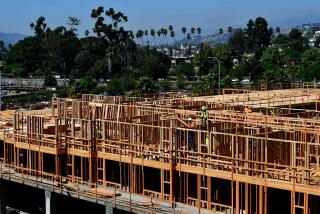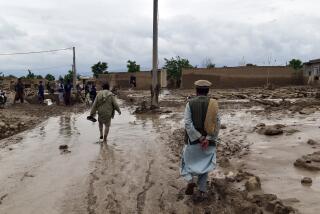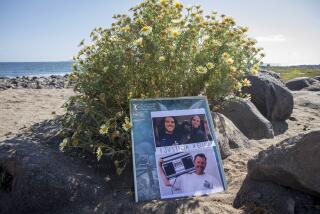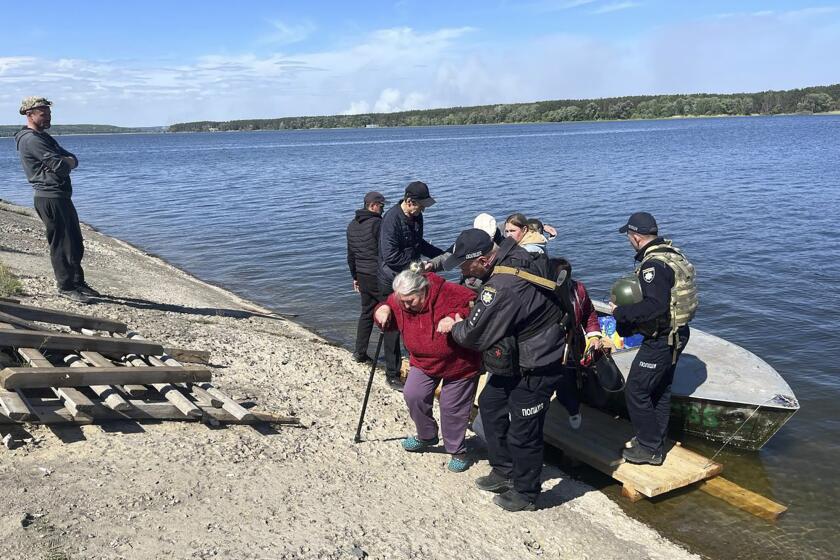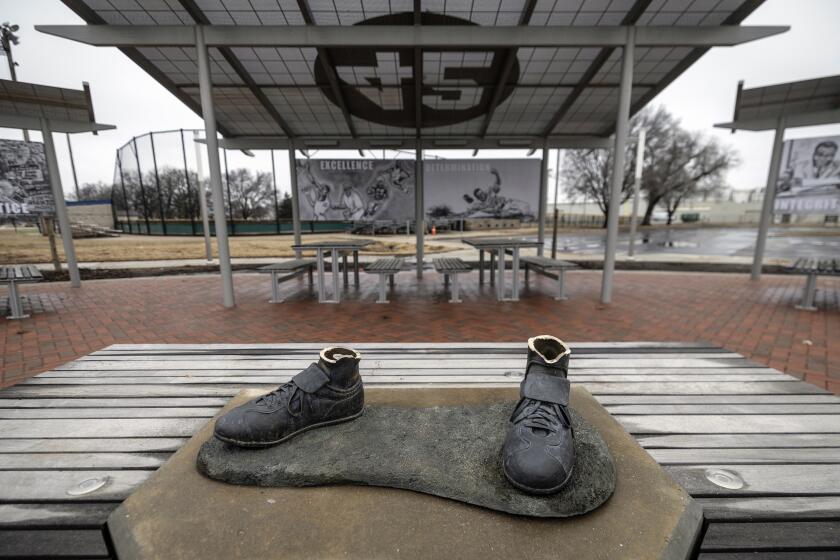Perils of War Remain in the Soil of Vietnam
Scattered through this town near the old Demilitarized Zone, 2,000 red signs with skulls and crossbones warn, “Danger!! Mines!!” For many, the alert comes too late: 29 years after the war’s end, the land still yields a harvest of death.
“I’m OK with my situation now,” says Do Thien Dang, 41, who lost both legs as a teenager when an unexploded U.S. artillery round went off while he was digging an irrigation ditch. “But every time my daughters go out, I tell them, ‘Be careful. There is danger all around.’ ”
Here in Quang Tri Province, 2,540 Vietnamese were killed and 4,243 wounded by land mines and ordnance between 1975 when the war ended and 2002, and such explosives detonate five times a week on average, according to a recent survey by an American veterans group. Most of the casualties occurred while farming, scavenging for metal or playing with objects that turned out to be explosives.
“For years, donor grants went to clearing old military bases because people thought that’s where the prime danger was,” said Chuck Searcy, an American veteran of the Vietnam War and an anti-land-mine activist based in Hanoi. “It turns out only 5% of the casualties were there. The real problem is the farmland where, due to floods and cultivation, buried [unexploded ordnance] slowly works its way toward the surface, just like a splinter in your finger does.”
Demining projects underway in Vietnam since 1996 have made limited progress. Two new projects enthusiastically supported by Hanoi’s communist government could eliminate the residue of war and make Vietnam’s land safe again, ordnance demolition experts say. Two groups of U.S. Vietnam veterans are driving the campaign.
“American veterans have a history of returning to their former battlefields -- building schools, libraries, orphanages and helping with a variety of different humanitarian efforts,” said Jan Scruggs, founder and president of the Vietnam Veterans Memorial Fund, or VVMF. “This process of reconciliation not only helps those in need, but also provides a tremendous amount of psychological healing to veterans who stood on opposing sides.”
The memorial fund’s project is called RENEW. In Trieu Phong, a door-to-door survey has produced the first comprehensive database of a contaminated area and the socioeconomic impact of land mines. It has established the location of danger zones, determined how explosions happened and who got killed or wounded. Vietnamese demolition teams will soon collect and destroy the unexploded ordnance at the 2,000 flagged sites.
“The war is still killing people here,” said Ho Xuon Thu, 47, a rehabilitation specialist at nearby Dong Ha hospital. “But maybe this is the start of a solution. With a database, you can attract donors. You can develop strategies for mine action. You can determine who is most at risk.”
RENEW also has helped disabled land-mine victims become mushroom farmers -- the crop requires little mobility or dexterity to harvest -- and has developed a land-mine awareness campaign, with TV spots and a troupe of children that travels to provincial villages to explain to kids, in song and dance, the dangers of land mines.
“I didn’t realize bombs that lived in the earth were alive after so many years,” said Duong Dinh Lieu, 40, who lost an arm to ordnance and is one of the new mushroom farmers. “I don’t remember anything. Boom! And then I’m in the hospital. I tried an artificial limb, but it didn’t fit and pinched. So now I have the stump.”
Another veterans’ group, Vietnam Veterans of America Foundation, or VVAF, recently received Hanoi’s approval to extend the VVMF survey into other provinces. The demining effort involves cooperation with Vietnam’s military, which traditionally has been suspicious of foreigners but recently has grown closer to the United States.
VVAF’s founder, Robert Muller, a paraplegic as a result of war wounds suffered as a Marine, in 1981 led the first group of U.S. servicemen to return to Vietnam after the war. His organization has provided artificial limbs to 7,000 Vietnamese land-mine victims since 1994 and in February was lauded by Deputy Prime Minister Vu Khoan for promoting reconciliation between the U.S. and Vietnam.
Humanitarian organizations say 3 million land mines and more than 300,000 tons of unexploded ordnance still litter Vietnam, one of the most heavily bombed countries in the world. The ordnance denies farmers access to potential rice fields and retards national development. When, for instance, Ford Motor Co. decided to build a plant outside Hanoi in the mid-1990s, 300 mines and ordnance items had to be removed from the property before construction could proceed. In Quang Tri, housing projects are on hold because of dangers posed by unexploded ordnance.
“I fled Quang Tri with my family in 1972 because of the fighting,” said Tran Van Khoi, a rehabilitation technician at Dong Ha hospital. “When we came back after the war in 1975, the first thing I noticed was there weren’t any houses.”
Of the province’s 3,500 villages, only 75 survived the war intact, officials said.
German, Australian, British and U.S. groups have run demining projects in Quang Tri province -- generally without coordination and often in competition with one another for donors’ financial backing. In eight years they have cleared 2,400 acres at a cost of about $10 million; 526,000 acres remain uncleared. Provincial officials say the new databases will help them develop an overall strategy.
Although annual casualties have lessened over the years in Vietnam as land mines have exploded or been destroyed, Vietnam estimates that 10% of its land remains contaminated and places the number of land mine and ordnance victims at 100,000 since 1975. Since 150 nations signed a treaty banning land mines in 1997, 52 million land mines have been collected and destroyed worldwide. The U.S. did not sign the treaty.
More to Read
Start your day right
Sign up for Essential California for news, features and recommendations from the L.A. Times and beyond in your inbox six days a week.
You may occasionally receive promotional content from the Los Angeles Times.
